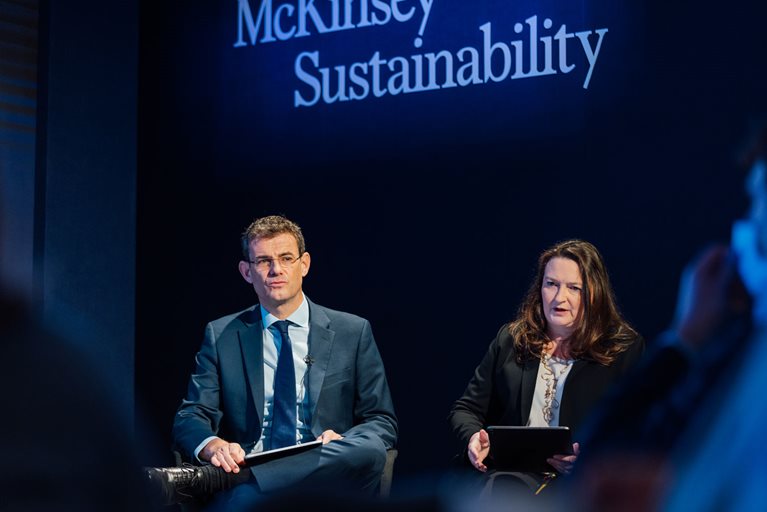The pathway to net zero by 2050 is narrow—and the evidence shows it will require organizations to dedicate themselves to fundamental, system-level change. Companies around the world will have to decarbonize their operations and business portfolios, ramp up production of climate technologies, apply new measures of corporate performance, and engage in thoughtful dialogue with investors.
Making all this happen won’t be easy. In McKinsey’s opening panel discussion on day one of COP26, speakers shared ideas for how to get there, as well as experiences that illustrate the possibilities. Here are some highlights, which have been lightly edited for clarity:
Highlights from day one
This will require the largest capital reallocation in human history. Our analysis suggests it’s going to be about $9 trillion a year for the next three decades, covering all investment into energy and land-use. That includes a 60 percent increase compared to current annual spending: $3.5 trillion of net new capital that’s going to need to be formed. Plus $1 trillion of capital that will need to be reallocated from high-emission assets to low-emission assets. That incremental spend of $4.5 trillion is equivalent to about half of all global profits, a quarter of all global tax revenues, and about 7 percent of household spending…. Two-thirds of this amount would need to go to developing countries and emerging markets.
—Dickon Pinner, global co-lead of McKinsey Sustainability and senior partner, McKinsey & Company
We are not one who says, “Divest your way out of the problem.” That is not our solution. We’re invested in the transition. What that means is, we are putting more resources than any other investment-management firm on the planet into engaging with companies—especially the 1,000 most carbon-intensive companies in our clients’ portfolios. And in that world, what we’re doing is we’re talking to them about the challenges. We’re asking them, “Tell us about the plans that you have. What will your company be doing in order to get to a global net-zero by 2050?” … Our goal is to spend time with companies, understand their targets, challenge them, and be a supportive investor.
—Sandra Boss, global head of investment stewardship, BlackRock
In 2018 we started having a conversation with our investors about an earnings per share [EPS] that would be adjusted with the cost of carbon.… The conversation was about the fact that if we were going to pay a dividend that is greater than the carbon adjustment, it would mean that the money which investors had given us for the good stewardship of the business would get returned to them before it had actually done all the work that it should do [to lower emissions]—that we had not enough invested enough in the long term. The second aspect was that this carbon-adjusted EPS would grow faster than the IFRS [International Financial Reporting Standards] EPS because peak emissions had been reached and would decline. Therefore, the gap [between them] would be reduced, and the carbon-adjusted EPS would be a growth driver, freeing dividend capacity faster than the IFRS EPS.
—Emmanuel Faber, climate and corporate social activist, partner at Astanor Ventures, chairman of OP2B

We are navigating through monumental uncertainty. As we think about where to invest and how to shape strategy, we need to have a strategy which is resilient. The way we approached it is, we very much defined our ambition, which is reimagining energy for people and the planet; and a net-zero ambition to 2050 with underpinning short-, medium- and long-term targets…. We don’t know how this is going to play out. There are multiple outlooks. But there is a series of core beliefs which underpin [our strategy]: electrification doubles by 2050, with renewables providing the lion’s share of that; hydrogen needs to grow to 350 million or 600 million tons per annum in 2050; EV mobility.
—Giulia Chierchia, executive vice president, strategy & sustainability, bp
Technologically, research shows the pathway for abating and reducing carbon emissions to reduce climate change to below 1.5°C is achievable.… If [existing technologies] were deployed, they would abate more 85 percent of what we need. The final block consists of technologies that are still in R&D. All of that is positive and encouraging—but we shouldn’t minimize the effort it’s going to take to actually bring those technologies to fruition. It’s the combination of not only taking the 14 percent of technologies that are in R&D to full maturity, but also doing the work to make all technologies fully available across the globe.
—Virginia Simmons, managing partner, UK and Ireland, McKinsey & Company
I don’t think we talk enough about really systemic changes…. In my opinion, we will remain very badly off course until we tackle those really painful, deep-lying issues. It will require a total reimagining of the framework of the economy.
—Simon Mundy, Moral Money editor, Financial Times
From our venue at COP26
Watch the full recording of today’s panel discussion here. To register for our upcoming livestreamed events, visit this agenda page.
At a glance
Recent McKinsey analysis suggests that by 2030 UK businesses could supply more than £1 trillion worth of the goods and services needed for the net-zero transition. Opportunities span many sectors, from financial services and real estate to construction and manufacturing.

In depth
Learn more about the net-zero path for companies from these McKinsey articles:
Solving the net-zero equation: Nine requirements for a more orderly transition
Time is running out for business leaders who don’t have a ‘net zero’ strategy
Climate math: What a 1.5-degree pathway would take
How companies capture the value of sustainability: Survey findings